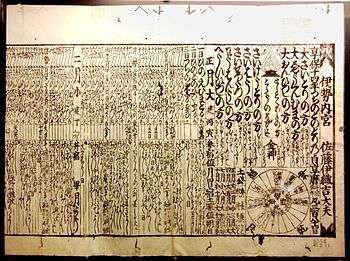Jōkyō calendar
The Jōkyō calendar (貞享暦, Jōkyō-reki) was a Japanese lunisolar calendar, in use from 1684 to 1753.[1] It was officially adopted in 1685.[2]

Jōkyō calendar published in 1729. Exhibit in the National Museum of Nature and Science, Tokyo, Japan.
History
The Jōkyō-reki system was developed and explained by Shibukawa Shunkai.[3] He recognized that the length of the solar year is 365.2417 days.[1]
Shibukawa discovered errors in the traditional Chinese calendar, the Senmyō calendar, which had been in use for 800 years.[3]
gollark: The current process is kind of crazy in my opinion.
gollark: <@433072575221071872> If I wanted, for some stupid reason, to add a driver to a windows install USB I'd google it.
gollark: It's madness.
gollark: `cmake` converts configuration into `make`files, which are their own format for "scripts" describing how to make things, which *then* runs the actual compiler when `make` is used with a target.
gollark: Glorp.
See also
References
- Nussbaum, "Jōkyō-reki" at p. 431; "Teikyō-reki" at p. 431
- Orchiston, Wayne et al. (2011). Highlighting the History of Astronomy in the Asia-Pacific Region, p. 155.
- Nussbaum, "Shibukawa Shunkai" at pp. 850–851.
External links
- National Diet Library, "The Japanese Calendar" -- historical overview plus illustrative images from library's collection
This article is issued from Wikipedia. The text is licensed under Creative Commons - Attribution - Sharealike. Additional terms may apply for the media files.